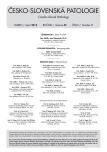Subependymálny obrovskobunkový astrocytóm s atypickými klinickými a patologickými črtami: diagnostická pasca
Authors:
Marián Švajdler jr. 1; Ladislav Deák 2; Boris Rychlý 3; Peter Talarčík 3; Lucia Fröhlichová 1
Authors‘ workplace:
Department of pathology, L. Pasteur’s University Hospital, Košice, Slovakia
1; Department of pediatric oncology and haematology, Children’s University Hospital, Košice, Slovakia
2; Cytopathos s. r. o., Bratislava, Slovakia
3
Published in:
Čes.-slov. Patol., 49, 2013, No. 2, p. 76-79
Category:
Original Article
Overview
Subependymálny obrovskobunkový astrocytóm (SEGA) je benígny pomaly rastúci tumor asociovaný so syndrómom tuberóznej sklerózy. Vyskytuje sa takmer výlučne v oblasti foramen Monro. Šírene do parenchýmu hemisféry a znepokojujúce histologické črty ako sú nekrózy, mitózy, mikrovaskulárna proliferácia a pleomorfia sú nezvyčajné, ale vzácne môžu byť prítomné. Prezentujeme prípad SEGA u pacienta, u ktrorého zatiaľ nie sú prítomné ďalšie známky syndrómu tuberóznej sklerózy, s atypickým radiologickým nálezom a mikroskopicky prítomnými nekrózami. Tieto znepokojujúce črty iniciálne viedli k nesprávnej diagnóze glioblastómu. Je diskutovaná diferenciálna diagnóza SEGA.
Kľúčové slová:
subependymálny obrovskobunkový astrocytóm – atypický – nekróza
Sources
1. Perry A. Familial tumor syndromes. In: Perry A, Brat D, eds. Practical surgical neuropathology. A diagnostic approach. Philadelphia, Churchil Livingstone/Elsevier; 2010: 427-453.
2. Lopes MBS, Wiestler OD, Stemmer-Rachaminov AO, Sharma MC. Tuberous sclerosis complex and subependymal giant cell astrocytoma. In: Louis DN, Ohgaki H, Wiestler OD, Cavenee K, eds. World health organisation classification of tumors. WHO classification of tumors of the central nervous system (4th ed). Lyon, IARC; 2007: 218-221.
3. Crino PB, Nathanson KL, Henske EP. The tuberous sclerosis complex. N Engl J Med 2006; 355(13): 1345-1356.
4. Grajkowska W, Kotulska K, Jurkiewicz E, et al. Subependymal giant cell astrocytomas with atypical histological features mimicking malignant gliomas. Folia Neuropathol 2011; 49(1): 39-46.
5. Stavrinou P, Spiliotopoulos A, Patsalas I, et al. Subependymal giant cell astrocytoma with intratumoral hemorrhage in the absence of tuberous sclerosis. J Clin Neurosci 2008; 15(6): 704-706.
6. Ichikawa T, Wakisaka A, Daido S, et al. A case of solitary subependymal giant cell astrocytoma: two somatic hits of TSC2 in the tumor, without evidence of somatic mosaicism. J Mol Diagn 2005; 7(4): 544-549.
7. Takei H, Adesina AM, Powell SZ. Solitary subependymal giant cell astrocytoma incidentally found at autopsy in an elderly woman without tuberous sclerosis complex. Neuropathology 2009; 29(2): 181-186.
8. Sharma MC, Ralte AM, Gaekwad S, Santosh V, Shankar SK, Sarkar C. Subependymal giant cell astrocytoma—a clinicopathological study of 23 cases with special emphasis on histogenesis. Pathol Oncol Res 2004; 10(4): 219-224.
9. Raju GP, Urion DK, Sahin M. Neonatal subependymal giant cell astrocytoma: new case and review of literature. Pediatr Neurol 2007; 36(2): 128-131.
10. Pizer B. Congenital subependymal giant cell astrocytoma diagnosed on fetal MRI. Arch Dis Child 2006; 91(6): 520.
11. Christoforidis GA, Drevelegas A, Bourekas EC, Karkavelas G. Low-grade gliomas. In: Drevelegas A, ed. Imaging of Brain Tumors with Histological Correlations, 2nd ed. Berlin-Heidelberg, Springer-Verlag; 2011: 73-156.
12. Bollo RJ, Berliner JL, Fischer I, et al. Extraventricular subependymal giant cell tumor in a child with tuberous sclerosis complex. J Neurosurg Pediatr 2009; 4(1): 85-90.
13. Isik U, Dincer A, Sav A, Ozek MM. Basal ganglia location of subependymal giant cell astrocytomas in two infants. Pediatr Neurol 2010; 42(2): 157-159.
14. Lopes MB, Altermatt HJ, Scheithauer BW, Shepherd CW, VandenBerg SR. Immunohistochemical characterization of subependymal giant cell astrocytomas. Acta Neuropathol 1996; 91(4): 368-375.
15. Buccoliero AM, Franchi A, Castiglione F, et al. Subependymal giant cell astrocytoma (SEGA): Is it an astrocytoma? Morphological, immunohistochemical and ultrastructural study. Neuropathology 2009; 29(1): 25-30.
16. Sharma M, Ralte A, Arora R, Santosh V, Shankar SK, Sarkar C. Subependymal giant cell astrocytoma: a clinicopathological study of 23 cases with special emphasis on proliferative markers and expression of p53 and retinoblastoma gene proteins. Pathology 2004; 36(2): 139-144.
17. Chow CW, Klug GL, Lewis EA. Subependymal giant-cell astrocytoma in children. An unusual discrepancy between histological and clinical features. J Neurosurg 1988; 68(6): 880-883.
18. Telfeian AE, Judkins A, Younkin D, Pollock AN, Crino P. Subependymal giant cell astrocytoma with cranial and spinal metastases in a patient with tuberous sclerosis. Case report. J Neurosurg 2004; 100(5, Suppl Pediatrics): 498-500.
19. Tihan T, Vohra P, Berger MS, Keles GE. Definition and diagnostic implications of gemistocytic astrocytomas: a pathological perspective. J Neurooncol 2006; 76(2): 175-183.
20. von Deimling A, Burger PC, Nakazato Y, Ohgaki H, Kleihues P. Diffuse astrocytoma. In: Louis DN, Ohgaki H, Wiestler OD, Cavenee K, eds. World health organisation classification of tumors. WHO classification of tumors of the central nervous system (4th ed). Lyon, IARC; 2007: 25-29.
21. Avninder S, Sharma MC, Deb P, et al. Gemistocytic astrocytomas: histomorphology, proliferative potential and genetic alterations—a study of 32 cases. J Neurooncol 2006; 78(2): 123-127.
22. Takei H, Florez L, Bhattacharjee MB. Cytologic features of subependymal giant cell astrocytoma: a review of 7 cases. Acta Cytol 2008; 52(4): 445-450.
Labels
Anatomical pathology Forensic medical examiner ToxicologyArticle was published in
Czecho-Slovak Pathology

2013 Issue 2
Most read in this issue
- Nediagnostikovaná Whippleova choroba s letálnym koncom
- Primární velkobuněčný neuroendokrinní karcinom močového měchýře
- Difuzní idiopatická hyperplázie neuroendokrinních buněk: popis případu a přehled literatury
- Nová zárodečná mutace v CYLD genu u slovenského pacienta s Brookeovým-Spieglerovým syndromem
